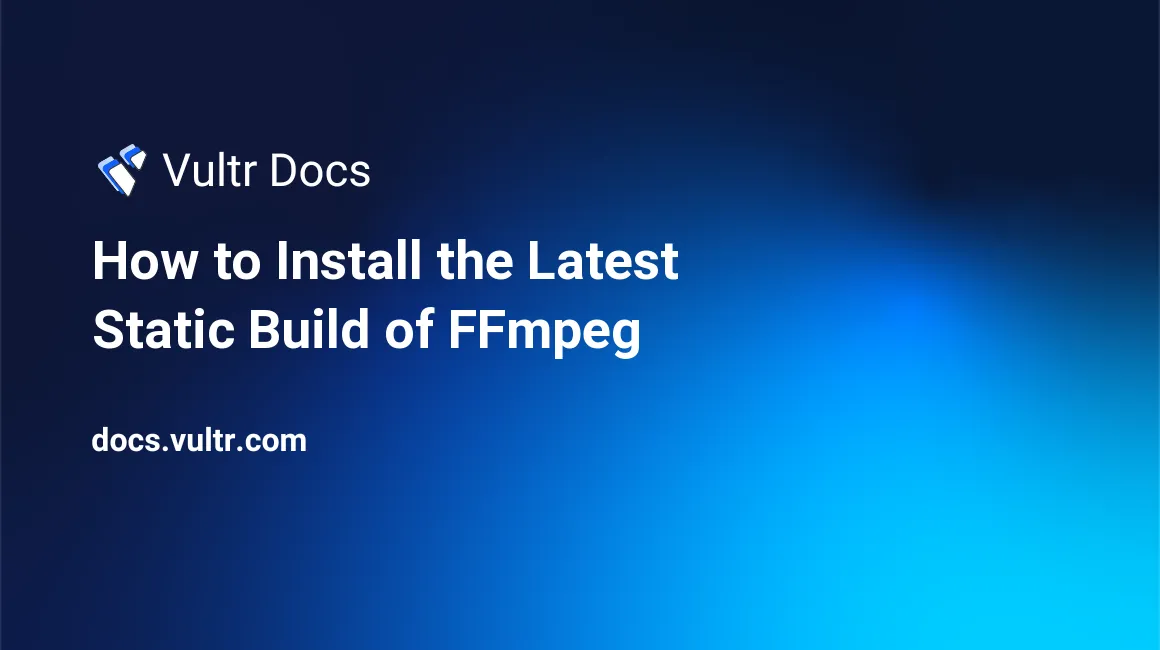
Introduction
FFmpeg is a complete cross-platform solution to record, convert, and stream audio and video. This tutorial will show you how to install the latest version of FFmpeg. This guide uses Ubuntu 20.04 as an example, but will work on Debian 10, Centos 8, Fedora 32, and any Linux system with kernels 3.2.0 and up.
Prerequisites
- A fully-updated Ubuntu 20.04 server.
- A non-root sudo user.
About the two branches of FFmpeg
The FFmpeg project maintains two branches of its source codes: master and release. The master branch receives faster bug fixes, additional features, and security patches. It works well 99% of the time and is recommended for normal use.
Approximately every six months, the FFmpeg project makes a stable release, which includes selected changes from the master branch. Between major releases, point releases will appear that add important bug fixes but no new features. This tutorial provides instructions for both branches, choose the branch that meets your need.
Install FFmpeg
🤚 Attention: Uninstall any existing versions of FFmpeg to avoid conflicts.
Create a folder to store the static build.
$ sudo mkdir -p /opt/ffmpeg $ cd /opt/ffmpegDownload the archive.
If using the master build:
$ sudo wget https://johnvansickle.com/ffmpeg/builds/ffmpeg-git-amd64-static.tar.xz $ sudo wget https://johnvansickle.com/ffmpeg/builds/ffmpeg-git-amd64-static.tar.xz.md5 $ md5sum -c ffmpeg-git-amd64-static.tar.xz.md5If using the release build:
$ sudo wget https://johnvansickle.com/ffmpeg/releases/ffmpeg-release-amd64-static.tar.xz $ sudo wget https://johnvansickle.com/ffmpeg/releases/ffmpeg-release-amd64-static.tar.xz.md5 $ md5sum -c ffmpeg-release-amd64-static.tar.xz.md5Verify that md5sum returns an OK message before proceeding with the installation.
Extract the static build from the archive.
$ sudo tar xvf ffmpeg*.xz $ cd ffmpeg-*-static $ lsYou will see something like this:
ffmpeg ffprobe GPLv3.txt manpages model qt-faststart readme.txtInstall the binaries globally.
$ sudo ln -s "${PWD}/ffmpeg" /usr/local/bin/ $ sudo ln -s "${PWD}/ffprobe" /usr/local/bin/
Test FFmpeg
Go to your home folder and download a video file.
$ cd ~ $ wget https://archive.org/download/BigBuckBunny_124/Content/big_buck_bunny_720p_surround.mp4 -O origin.mp4Convert it to streaming compatible version.
$ ffmpeg -i origin.mp4 -c copy -movflags +faststart streaming.mp4Verify the resulting video with ffprobe:
$ ffprobe streaming.mp4If you see output like this, FFmpeg is working properly.
Input #0, mov,mp4,m4a,3gp,3g2,mj2, from 'streaming.mp4': Metadata: major_brand : isom minor_version : 512 compatible_brands: isomiso2avc1mp41 title : Big Buck Bunny - https://archive.org/details/BigBuckBunny_124 encoder : Lavf58.49.100 comment : license:http://creativecommons.org/licenses/by/3.0/ Duration: 00:09:56.50, start: 0.000000, bitrate: 829 kb/s Stream #0:0(und): Video: h264 (Constrained Baseline) (avc1 / 0x31637661), yuv420p, 640x360 [SAR 1:1 DAR 16:9], 697 kb/s, 24 fps, 24 tbr, 12288 tbn, 48 tbc (default) Metadata: handler_name : VideoHandler Stream #0:1(und): Audio: aac (LC) (mp4a / 0x6134706D), 44100 Hz, stereo, fltp, 128 kb/s (default) Metadata: handler_name : SoundHandler
Conclusion
If you want to learn more about FFmpeg, see the following resources.
- FFmpeg's official website provides the latest news and source codes of the project.
- The FFmpeg Static Builds website provides the latest builds for Linux kernels 3.2.0 and up.
- The FFmpeg Wiki provides how-to guides contributed by community users.